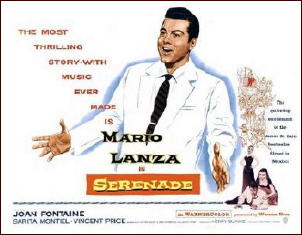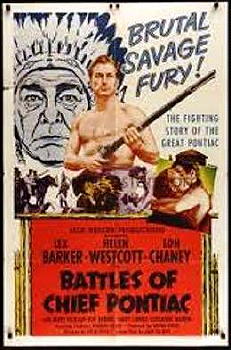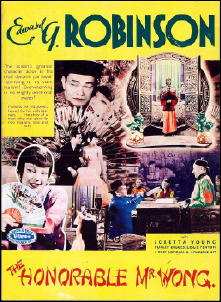July 2014
Monthly Archive
Thu 10 Jul 2014
Posted by Steve under
Reviews[2] Comments
THE ARMCHAIR REVIEWER
Allen J. Hubin
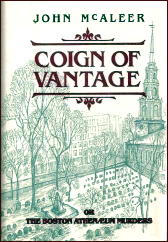
JOHN McALEER – Coign of Vantage; or, The Boston Athenaeum Murders. Foul Play, hardcover, 1988. No paperback edition.
After a biography and bibliography of Rex Stout, after studies of Emerson, Thoreau and Dreiser, after a Korean War novel, a professor of English at Boston College offers his first mystery novel. This is John McAleer, and his debut is Coign of Vantage.
The scene is first the Cat-Tail Club, a rarefied Boston literary society, three of whose members, vastly aged, have recently died. No matter their age, the odor of fish is detected, and Austin Layman, by no means a member but able to keep up his conversational end as if he were, is invited to have a look.
The scent leads to the Boston Athenaeum, august gentleman’s library, where apparently for innocent repose for forty years have lain scandalous manuscript pages now capable — wonder of wonders — of exciting passions, even murder, in geriatric literary breasts.
Full of sprightly dialogue, fabulous characters, and wit is this novel, and much to be pleasured, with only some weakness at the end to be regretted.
— Reprinted from The MYSTERY FANcier,
Vol. 11, No. 3, Summer 1989.
Bibliographic Note: This is John McAleer’s only entry in Al Hubin’s Crime Fiction IV.
Thu 10 Jul 2014
THE BACKWARD REVIEWER
William F. Deeck
PETER PIPER [THEO LANG] – The Corpse That Came Back. Random House, US, hardcover, 1954. First published in the UK: Hodder & Stoughton, hardcover, 1952, as Death in the Canongate.
The fairly portly chess-playing Detective-Inspector O. (as in Oliver, though his name isn’t Oliver) Gray of Scotland Yard is in Edinburgh to attend as many concerts as possible at the International Festival. When the local police ask him to take a hand in the investigation of the appearance of the corpse of Bailie Andrew Maclachlan, who had planned his own funeral to the minutest detail and had been cremated, or so everyone thought, Gray disrupts, but only a little, his plans.
He manages to get in his sightseeing, giving readers a splendid rendering of the tourist’s Edinburgh, and the musical offerings of the Festival while discovering why the corpse has turned up most unexpectedly.
A police procedural both interesting and amusing, one of seemingly only two featuring Gray. This is a pity, for Gray is a delightful character.
According to Random House, Lang wrote under a pseudonym while he was in the British Army during World War II because he didn’t want to go through the red tape of getting permission to write. After writing several books on walking trips, Lang wrote a series of books about the antiquities of Scotland.
— From
The MYSTERY FANcier, Vol. 11, No. 3, Summer 1989.
Bibliographic Notes: Bill was in error, or rather two, when he wrote up his notes on this book. There were three Inspector Gray books, the other two being Murder After the Blitz (Hurst, 1943) and Death Came in Straw (Hurst, 1945), neither of which had US editions and hence are as scarce as hen’s teeth today. And Piper’s real name was Theo Langbehn, although he did write one mystery as Theo Lang.
As Peter Piper, he wrote two other works of crime fiction, both in Hubin, with no series characters noted. What has always been a problem for me, is trying to keep from being confused between the author Peter Piper, and the character Katherine “Peter†Piper, who appeared in seven works of detection fiction by Amelia Reynolds Long, but I think I finally have them straight now.
Wed 9 Jul 2014
Reviewed by DAVID VINEYARD:
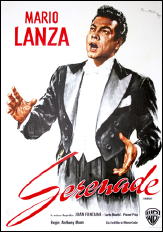
SERENADE. (1956) Mario Lanza, Joan Fontaine, Vincent Price, Sarita Monteil, Vince Edwards, Harry Bellaver, Joseph Calleia. Screenplay Ivan Goff, Ben Roberts & John Twist, based on the novel by James M. Cain. Directed by Anthony Mann.
After a four year hiatus, this was to have been Mario Lanza’s triumphant return to the screen.
As such it’s hardly a triumph.
Serenade is James M. Cain’s finest book according to most critics, and his biographer Roy Hoopes, and for once I agree. It’s a dark symbolic journey through hell to a kind of redemption complete with a Christ-like sacrifice. It tackles big themes, and for its time is quite blatant about the heroes bi-sexuality, and his reclamation of his manhood (Cain’s theme, not mine, so go after him if you must) thanks to Juana, an earthmother-like Mexican prostitute.

The hero of the novel is a gifted singer who threw away his talent on pop music, thanks to his Svengali-like impresario and lover. On the skids, he has gone south to Mexico where he meets Juana, a woman he once had a passionate affair with, and after a death, they go on the run.
Heavy on symbolism, the scene where the hero and Juana make love in the abandoned church, the sharks and the iguanas are all justly well remembered elements of the novel, and the hero’s plight becomes a metaphor for the corruption of modern society. Though readers here might prefer The Postman Always Rings Twice, Mildred Pierce, or Love’s Lovely Counterfeit, this is Cain’s greatest achievement as a novelist.
The movie, not so much. Imagine trying to make a musical and woman’s picture of Under the Volcano or Day of the Locust, and that might be easier than this book.
We open with Mario Lanza being discovered in the California vineyards. Under the guidance of beautiful but cruel Kendal Hale (Joan Fontaine) he loses his voice and flees her to Mexico where he meets young beautiful, rich, and passionate Juana Montes (Sarita Monteil). She is attractive, but hardly any of those other things Juana represents in the novel, and the scene where she dresses like a matador at a party and battles a mock bull is supposed to mirror a scene in the book, but instead plays like bad comedy.
After the fourth musical number in the first twenty minutes, and following the awful title number by the usually great Sammy Cahn, you know this film has abandoned Cain for standard women’s picture country. That might have worked in Douglas Sirk’s hands, but this is clearly not a comfort zone for director Anthony Mann and screenwriters Goff, Roberts, and Twist.
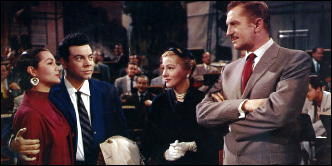
Vincent Price is good as Lanza’s friend and ally, but all you can think of watching him, is what he might have done as the controlling homosexual impresario.
Granted, you couldn’t film Cain’s novel without a great deal of obfuscation at that time in Hollywood, but it didn’t have to be turned into this big Technicolor turkey either. A good noirish black and white film is lurking beneath this clown show.
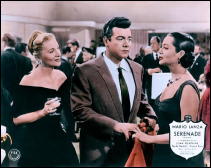
The novel is a blend of Hemingway, Graham Greene, and Christopher Isherwood in Cain’s own unique voice. It is full of memorable scenes, imagery that will stick in your mind, dark under currents tugging like riptides at unwary readers, and the restoration of the hero’s voice becomes a metaphor for his soul and his manhood.
In the film the attractive Sarita Monteil couldn’t redeem Green Stamps, lives in a palatial ranchero William Randolph Hearst might envy, and it’s hard to believe she and Lanza like each other, much less become so indelibly tied that she virtually becomes his lost soul.

Fontaine and Price try hard, but there is nothing here to work with. Mann does nothing that remotely resembles Anthony Mann, and the story plays as if it was written from Cliff Notes of the novel or the Classics Illustrated version.
This is bad soap opera and a mediocre musical, with a star who returns to the screen fat and unconvincing. He isn’t bad, but at most he seems peeved rather than tortured by his lost voice and by implication masculinity. I’ve displayed more angst when I mislaid the car keys.
The novel is dark, sensual, powerful, shocking, blatantly sexual, violent, noirish, and symbolic. It has the quality of a nightmare, but there is no awakening, only an ironic sort of redemption out of sacrifice and tragedy.
Serenade the film is tired, trite, empty, slick, pointless, and disappointing. It did nothing to rebuild Lanza’s fading career, and stands as a black mark against Anthony Mann.
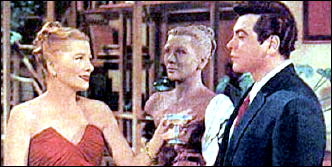
The problem is that Serenade is exactly the movie you would expect Hollywood to make of Cain’s novel in the nineteen fifties. It is so what you would expect you could do a better satirical film about how Hollywood corrupts this kind of book. It is far and away Cain’s least film adaptation, and a sad fate for a stunning novel.
The music is bad and Lanza fat, so his fans have no reason to watch it; the film is flat and unimaginatively shot so Mann fans have no reason to watch it even as completists. There is no redeeming performance by anyone who hasn’t been better elsewhere, the script is dull, and even Mexico doesn’t look that good in widescreen Technicolor.
Read the book then rent Double Indemnity if you need a dose of James M. Cain’s unique perspective.
Wed 9 Jul 2014
Posted by Steve under
Reviews[3] Comments
JOHN BUDE – The Lake District Murder. British Library Crime Classics, UK, softcover, 2014. First edition: Skeffington & Son, UK, hardcover, 1935. No US edition.
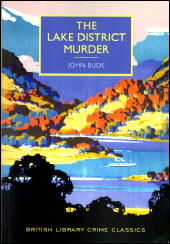
One positive statement I can make about this recent reprint of an old obscure British mystery is that it describes both the time and place of its setting in very enjoyable, if not loving detail. The Lake District is located in the northwest corner of England, up not too far from the Scottish border. In 1935 at least, it was filled with small picturesque villages and shopping centers and long stretches of isolated roads, populated by only the occasional petrol station.
And it is in one of these petrol stations that the body of one of the two co-owners is found dead, an apparent suicide — the man seems to have shut himself up in a shed with the engine of a car running.
Suicide is the obvious conclusion, of course, but Inspector Meredith, second on the scene, has his doubts. The man’s dinner was prepared and sitting in his kitchen waiting for him. An autopsy soon proves the inspector correct.
The problem is that all of Meridith’s suspects have iron-clad alibis, and it takes the rest of book to work out in detail how they managed to pull off the murder, which was planned to the smallest of details. Except for the meal, of course!
And mind you, if you were to slog your way through the middle 80% of the book (a verb chosen quite carefully on my part), you will learn far more than you want to know about the wholesale petrol delivery business, including the size of hoses, nozzles, storage tanks, and rate of delivery. How on earth could a delivery truck deliver on a given day 200 more gallons of petrol than the tank in the truck could hold?
It is a puzzle but it is also a matter easily explained, once it is decided that the impossible really is impossible, but the solution to that small enigma only produces another, nor is there still enough evidence to insure a conviction. Until that is, a small boy’s find puts Meredith on the right track, a small boy not mentioned before, I reluctantly have concluded, and if Meredith had remembered the incident at the time of the inquest, much of the huge amount of dogged down-to-earth pre-forensics lab police work may have been avoided.
Are my quibbles outweighed by the fascinating trip back in time and place that a book such as this provides? You’ll have to answer that question for yourself. I know I’ll never read this one again, but all in all, I’m happy to have had the chance to read it for the first time.
Tue 8 Jul 2014
Posted by Steve under
ReviewsNo Comments
INGRID THOFT – Loyalty. G. P. Putnam’s Sons, hardcover, June 2013. Berkley, premium paperback, March 2014.
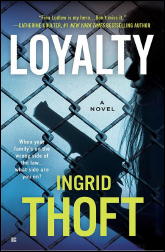
What we have here is a tome, a solid 474 page book with tall pages of small print in the paperback edition. You get your money’s worth, I think, especially if you’re a fan of PI novels, and even more especially if you’re a fan of female PI detective novels.
The PI being Fina Ludlow, daughter of Carl Ludlow, a notorious Boston lawyer, and sister to three more lawyers in the family, all male. Although she works for the firm, she is the odd person out — rebellious, tough and outspoken — but when it comes to the missing wife of brother Rand, she is on the job and nothing else but the job until the job is done.
I do kind of wish that it hadn’t taken her so long to do it. As you might expect in a book as long as this one is, the middle section becomes a bit of a grind. I also wish the ending weren’t quite so obvious. I think most readers will catch on to what’s happening (or what happened) long before Fina does.
You can blame this on two things. (1) a prologue of sorts (although it’s not called that) in which what happened to Fina’s sister-in-law is described long before we even know her name, and a parallel story in which the story of the villainess in question is told, although we the reader do not know at once how the two stories converge and connect up, and (2) perhaps Fina unconsciously refuses to believe that someone, or someones, plural, in her family could do or be responsible for such misdeeds, as actually turns out to be the case.
There is already a second book in the series, Identity, and you can buy it in hardcover now. In spite of my misgivings, as stated above, I think I will will buy it, but I will definitely wait for the paperback. Not to mention a time in my life when I have a month of free time available to me. (Do you think I’m joking? Not so much.)
Tue 8 Jul 2014
WILL ERMINE – My Gun Is My Law. Pocket 911; paperback reprint; 1st printing, November 1952. Hardcover editions: William Morrow, October 1942; Grosset & Dunlap, 1946; Jefferson House “Triple-A Western Classic,†March 1950. Also published in Double-Action Western, May 1943 (perhaps abridged). Introduction to Jefferson House and Pocket editions by Erle Stanley Gardner.
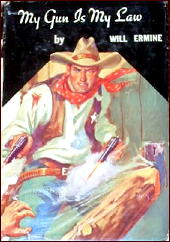
I didn’t know this before doing some research on the subject, but as it so happens, Will Ermine is one of several pen names that Harry Sinclair Drago (1888-1979) used to write westerns, including his own.
Another of Drago’s assumed aliases is Bliss Lomax, which I knew, and a quick dive into the Internet produced some other information. Not all of his books were westerns, for example. One of his books, Playthings of Desire (Macaulay, 1924), as by J. Wesley Putnam, is about the illicit affairs of a Broadway actress, and was the basis for a silent film of the same name. Starring were Estelle Taylor, Mahlon Hamilton, Dagmar Godowsky and Mary Thurman. When the movie was produced again in 1933, the featured players were Linda Watkins, James Kirkwood, Reed Howes and Josephine Dunn.
None of these people were previously known to me. Perhaps they were household names at the time. Fame is sometimes a fleeting thing.
Getting back to western fiction, though, here’s an interesting look into the effort that Drago did to make his western fiction as authentic as possible. The paragraph below is taken from Richard Patterson’s introduction to a book that Drago did on the history of the west, Outlaws on Horseback: The History of the Organized Bands of Bank and Train Robbers Who Terrorized the Prairie Towns of Missouri, Kansas, Indian Territory, and Oklahoma for Half a Century, reprinted by the University of Nebraska Press in 1998:
“Although Harry Sinclair Drago did most of his writing within a cab ride of New York’s Hudson River, he probably knew parts of the American West better than some who spent their lives there. A committed researcher, Drago once memorized the names of over a thousand counties in the western states and territories. To avoid mistakes, he kept pages of an 1890 atlas pinned to the wall of his office.â€
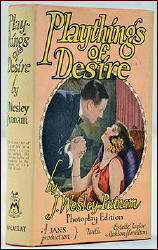
The original edition of this work was published by Bramall House in 1964. For another view of Drago’s attitude toward writing, I can’t tell you where the following quote first appeared, one I found on the Internet, but here it is anyway:
When asked how he wrote over 100 books: “Four pages a day, that’s how you write 100 books. That’s how you write books.â€
My Gun Is My Law is a title that really doesn’t have anything much to do with the book of the same name. As Erle Stanley Gardner points out in his introduction, the central theme of this western novel is the family feud. Two of the men who originally settled the hundred-mile length of Spirit Valley, Jube (Stonewall) Gordon and Rusty Cameron soon began fighting each other, their hatred beginning a quarrel between the two that lasted for forty years, claiming the lives of most of both men’s sons, not to mention scores of men who worked for either side.
For most of that time the feud was fought according to rules. From page 3:
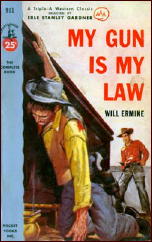
For one, you did not shoot an enemy in the back, or fire at him unless he was properly warned. Also, it was possible to meet him while he was on lawful business and unless he gave fresh offence you did not make war on him. It was a quixotic, even an absurd code; but it was a code, and in this Spirit Valley country there had always been black disgrace for the Cameron partisan or Gordon adherent who had dared violate it.
As you see, this is very much in the vein of the traditional western, which also means, of course, there is also a romance involved, no matter how serious and how deadly the feud between the two families may be. Here’s a rather long quote from page 10, and you’re probably way ahead of me on this. At a local dance, with both sides in attendance, and on their “best†behavior toward each other:
By now, every eye in the room was trained on Cape [Cameron] as he stood before Necia [Gordon], tall and straight, his blue eyes alive and reckless in his young face. With a grace few suspected he possessed, he bowed to her.
“Miss Gordon,†he said so softly that many could not hear, “might I have the honor of this dance with you?â€
Men and women held their breath, stunned by his request and certain that Necia would say no and put him in his place. They were in no doubt as to what would follow. Guns would talk here tonight. They knew they should be thinking of their own safety, getting out of the way. For the moment, however, they were helpless to do anything about it. A spell had been put on them, and they could only stare at Cape and Necia.
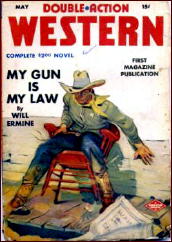
They saw him regard him with a curious interest, the color coming and going in her cheeks. She seemed calm enough, with Cape’s preposterous advance ringing in her ears and the eyes of everyone in the room on her. They knew she was alive to the significance of this moment and its inevitable consequences, and they told themselves that if she was slow to answer it was only because she wanted what she said to be adequate and final.
But, to their surprise, something flowed into her dark eyes that was warm and friendly. A smile parted her lips.
“I’d be most pleased to dance with you, Mr. Cameron,†she said simply and with a trace of her father’s familiar drawl.
With well over 150 pages of small print to go in the paperback edition, this is of course only the first step toward a truce, and not all of the characters survive to the end. As a matter of fact, the local doctor, a young fellow somewhat acquainted with the new science of ballistics, does a fine job of detective work, finding a killer in a shooting where no one was even suspected. Microscopes do come in handy! – even in a land where guns make up 90% of the law.
For a fellow that started early in the pulps (circa 1922), Drago/Ermine has a flair for the right word in the right place, albeit with a certain stiffness in the telling every so often. From this (admittedly) small sample of size one, I’d definitely say he’s worth seeking out and hunting down to read more of his work.
— Reprinted from Durn Tootin’ #7 , July
2005 (slightly shortened and revised).
Mon 7 Jul 2014
Reviewed by JONATHAN LEWIS:
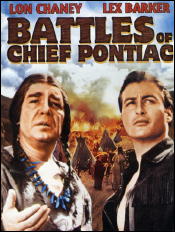
BATTLES OF CHIEF PONTIAC. Realart Pictures, 1952. Lex Barker, Helen Westcott, Lon Chaney Jr., Berry Kroeger, Roy Roberts. Director: Felix E. Feist.
Battles of Chief Pontiac is a good, albeit not great, historical drama/early frontier Western starring Lon Chaney Jr. and Lex Barker of Tarzan fame. Directed by Felix Feist, whose film noir, The Man Who Cheated Himself I reviewed here, the movie benefits from solid acting from Chaney in his portrayal of Ottawa Indian Chief Pontiac and from its on location South Dakota setting.
The film’s narrative and script, however, suffers from its forced moralism. While the filmmakers should be credited for their willingness to depict Indians as societally more complex than mindless warriors, they may have gone a bit overboard in their decision to depict Chief Pontiac as more as a seeker of peace than as the warrior he actually was. They chose, for instance, not to make the historical Chief Pontiac’s attack and siege on Fort Detroit the focus of their film.
The plot of the movie isn’t very complex, with few surprises or unexpected plot twists. Lt. Kent McIntire (Barker) is acting as a liaison between the British, led by Major Gladwin (Roy Roberts) and Ottawa Chief Pontiac (Chaney). His goal is to help establish peace between the two peoples. But things get complicated when Pontiac’s men take white hostages, including Winifred Lancaster (Helen Westcott) who — to no one’s surprise — becomes McIntire’s love interest.
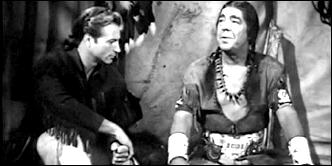
The real drama begins, however, when a Hessian officer, the incredibly creepy Colonel Von Weber (Berry Kroeger), takes over the reins from Major Gladwin. Von Weber is a racist to the core, spewing vitriol about the Indians. Truth be told, it’s all a bit undignified. The filmmakers could have made their point even better if they had chosen to be subtle about it.
In any case, Von Weber is a really bad guy and a bit too, should we say, Third Reich, for a film set in eighteenth-century Michigan.
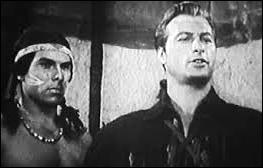
Although Pontiac is willing to enter into peace negotiations, the Hessian decides it would be better to deliver smallpox infested blankets to Pontiac’s people. This leads, of course, to both untold suffering on the part of the Ottawa Indians and therefore to Chief Pontiac’s decision to wage battle against the Von Weber and his men.
It’s then up to Tarzan — I mean, McIntire — to intercede so as to prevent a complete bloodbath. By the time it’s all over, Chief Pontiac is once again willing to make peace with the British, McIntire and Lancaster are in love, and Von Weber has suffered a rather horrific death from smallpox. Not that you are supposed to feel remotely sorry for him. He’s one of the least sympathetic characters I’ve ever seen in any historical drama.
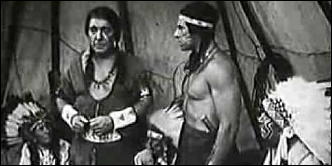
Chaney is actually very good in this. His voice and mannerisms are excellent, even if he is stuck at times with some embarrassingly bad dialogue. There are moments when he appears to be the only actor in the film taking it with the seriousness the subject matter deserves. As to how much of all this is historically accurate, probably not all that much.
In conclusion, Battles of Chief Pontiac is a well-meaning, low budget production that portrays Indians and their customs quite differently from other films of that era. It just doesn’t nearly live up to its potential.
—
Mon 7 Jul 2014
IT’S ABOUT CRIME
by Marv Lachman
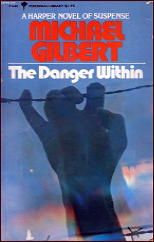
Five recent reprints from Perennial Library [as of 1989] testify to the remarkable quantity and quality we have come to expect from Michael Gilbert. His second mystery, He Didn’t Mind Danger (1947), has been reprinted in this country in paper for the first time in more than twenty years; Lancer had published it under its British title, They Never Looked Inside.
We follow Major Angus McMann, who is shaken out of his boredom in post-war London when he gets involved with a particularly well organized gang of jewel thieves and finds himself not only helping Scotland Yard but even having his military commission reactivated. Some of Gilbert’s later work might be smoother but he has never been livelier, nor more readable.
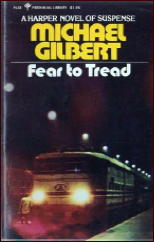
The Danger Within (1952) has a most unusual setting, an Italian prisoner-of-war camp for British soldiers, but it is one Gilbert knows full well because he was a captive during World War II, until he escaped. There is both humor and suspense as the British plan an escape, only to find there is a traitor in their midst whose identity must be detected.
Death Has Deep Roots (1951) also has its roots in World War II. A British attorney (Gilbert’s profession) is asked to defend a young French woman accused of murdering her lover, a war hero. The legal pyrotechnics are well handled, but the book succeeds most notably with its compassionate picture of the characters.
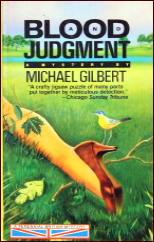
World War II’s black market continued during England’s post-war austerity far longer than in the United States, and in Fear to Tread (1953) a British schoolmaster innocently becomes involved with a criminal gang. Such is Gilbert’s skill that we identify compulsively with this amateur sleuth as he battles them.
Blood and Judgment (1951) is an early case for one of Gilbert’s few professional detectives, Inspector (then Sergeant) Petrella of Q Division. Gilbert’s first series detective, Inspector Hazelrigg from Scotland Yard, was very intelligent but a bit bland. Petrella is young, enthusiastic, error-prone, but ultimately a hero who shows that, on the few occasions he essayed them, Gilbert was one of the best writers of police procedurals.
— Reprinted from
The MYSTERY FANcier, Vol. 11, No. 3, Summer 1989.
Mon 7 Jul 2014
REVIEWED BY DAN STUMPF:
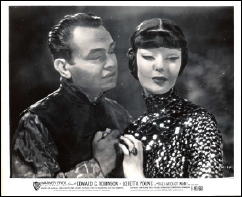
THE HATCHET MAN. First National Pictures / Warner Brothers, 1932. Also released as The Honorable Mr. Wong. Edward G. Robinson, Loretta Young, Dudley Digges, Leslie Fenton, Edmund Breese, Tully Marshall, J. Carroll Naish. Director: William A. Wellman.
Recently watched: The Hatchet Man, a Warners thing from 1932 with Edward G. Robinson as a respected Chinese Executioner working for the Tong in San Francisco. When he’s ordered to kill his best friend (played with slanty eye and lilting diphthong by Irishman J. Carroll Naish), he promises to look after his buddy’s daughter, and see that he never causes her any unhappiness… According to custom, this also includes marrying her.
Time passes. And it passes quickly, because this is a Warners film, and only runs 74 minutes anyway. The daughter grows up to be a very fetching Chinese-American (played by Loretta Young?!) who obligingly marries Robinson — now a prosperous businessman — because he’s nice to her and her father would have wished it.
She predictably falls for a flashy Chinese gangster about five minutes later, but when Eddie discovers them together he recalls his promise to Naish and breaks Custom by not killing them both. Instead, he allows them to go off together, a move that causes him serious loss of face in the community and eventual financial ruin.
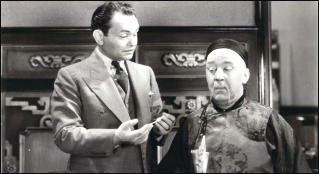
More time passes. Even quicker. Robinson, now a migrant field hand, gets word that Loretta and her new husband were deported to China, where he has put her to work in a brothel.
Remembering his vow still, he makes his way to China for a richly satisfying ending that somehow manages to be melodramatic and cynical at the same time.
This was directed by William Wellman at his tough best, and a real treat.
Sun 6 Jul 2014
Posted by Steve under
Reviews[2] Comments
THE ARMCHAIR REVIEWER
Allen J. Hubin
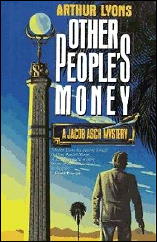
ARTHUR LYONS – Other People’s Money. Mysterious Press, hardcover, 1989; paperback, 1990.
The tenth case for private eye Jacob Asch is Other People’s Money, by Arthur Lyons. Mr. Saffarian asks Jacob to keep an eye on his daughter, who decamped from Istanbul with a furnace worker and lives with him in LA. Asch hires a team and they begin surveillance, reporting a few contacts to Saffarian, who then abruptly pulls Asch off the job.
End of story, it might seem, except one of Jacob’s team disappears. Now on his own, Asch works his way into a scheme involving smuggled antiquities, an avaricious collector and museum director, and death, the latter in goodly quantities.
Crisp narrative, wily plotting.
— Reprinted from The MYSTERY FANcier,
Vol. 11, No. 3, Summer 1989.
Note: Ray O’Leary reviewed this same title earlier on this blog some two and a half years ago. Look for it here. There were 11 Jacob Asch novels in all. A complete bibliography for Arthur Lyons was posted on this blog at the time of his death in 2008. Follow the link.
« Previous Page — Next Page »







